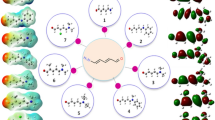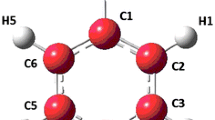Conclusions
-
1.
A complete analysis has been performed on the13C-satellite13C-{1H} NMR spectra of the benzene ring of trialkyl phenoxy derivatives of Si, Ge, and Sn.
-
2.
In this series of compounds, the degree of orbital overlapping of the 2p-electrons of the oxygen atom with the π-system of the benzene ring is practically independent of steric interactions.
-
3.
Only the 3d-orbital of the Si atom has appreciable π-acceptor properties in interaction with the unshared electron pairs of oxygen.
Similar content being viewed by others
Literature cited
A. I. Egorochkin, N. S. Vyazankin, and S. Ya. Khorshev, Usp. Khim.,41, 829 (1972).
C. J. Attridge, Organomet. Chem.,13, 259 (1968).
M. E. Dyatkina and N. M. Klimenko, Zh. Strukt. Khim.,14, 173 (1973).
D. F. Ewing, Org. Magn. Reson.,12, 499 (1979).
L. B. Krivdin, G. A. Kalabin, and B. A. Trofimov, Izv. Akad. Nauk SSSR, Ser. Khim., 275 (1982).
G. A. Kalabin, L. B. Krivdin, and B. A. Trofimov, Izv. Akad. Nauk SSSR, Ser. Khim., 113 (1982).
S. A. A. Linde and H. J. Jakobsen, J. Am. Chem. Soc.,98, 1041 (1976).
P. E. Hansen, Org. Magn. Reson.,11, 215 (1978).
V. Wray, Progr. NMR Spectrosc.,13, 177 (1979).
A. R. Katritsky, R. F. Pinzelli, and R. D. Topson, Tetrahedron,28, 3441 (1972).
P. S. Dewar, E. Ernstbrunner, J. R. Gilmore, M. Godfrey, and J. M. Mellor, Tetrahedron,30, 2455 (1974).
V. M. Bzhezovskii, G. A. Kalabin, I. A. Aliev, B. A. Trofimov, M. A. Shakhgel'diev, and A. M. Kuliev, Izv. Akad. Nauk SSSR, Ser. Khim., 1999 (1976).
G. A. Kalabin and D. F. Kushnarev, Dokl. Akad. Nauk SSSR,254, 1425 (1980).
W. Adcock, J. Alste, S. Q. A. Rizvi, and M. Aurangzeb, J. Am. Chem. Soc.,98, 1701 (1976).
V. Wray, L. Ernst, T. Lund, and H. J. Jakobsen, J. Magn. Reson.,40, 55 (1980).
M. Bullpit, W. Kitching, W. Adcock, and D. Doddrell, J. Organomet. Chem.,116, 161 (1976).
K. A. Andrianov, Methods of Heteroorganic Chemistry-Silicon [in Russian], Nauka, Moscow (1967).
M. Lesbre et al., Organic Compounds of Germanium, Wiley, New York (1971).
D. A. Kochkin and I. I. Azerbaev, Organotin and Organolead Monomers and Polymers [in Russian], Alma-Ata (1966).
Author information
Authors and Affiliations
Additional information
Translated from Izvestiya Akademii Nauk SSSR, Seriya Khimicheskaya, No. 9, pp. 2038–2042, September, 1982.
Rights and permissions
About this article
Cite this article
Krivdin, L.B., Kalabin, G.A., Mirskov, R.G. et al. NMR spectroscopic study of conjugation effects Communication 19. Electronic effects in trialkyl phenoxy derivatives of silicon, germanium, and tin. Russ Chem Bull 31, 1799–1802 (1982). https://doi.org/10.1007/BF00952380
Received:
Issue Date:
DOI: https://doi.org/10.1007/BF00952380




